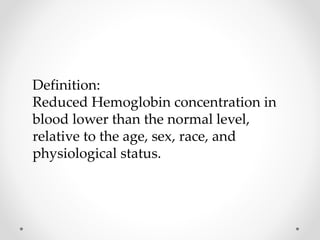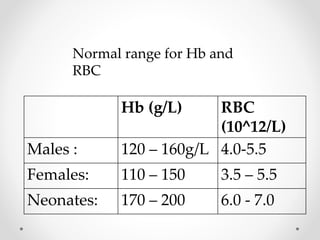Anemia presentation
- 1. Definition: Reduced Hemoglobin concentration in blood lower than the normal level, relative to the age, sex, race, and physiological status.
- 2. The importance of history taking and clinical examination in diagnosing anemia
- 3. Normal range for Hb and RBC Hb (g/L) Males : RBC (10^12/L) 120 â 160g/L 4.0-5.5 Females: 110 â 150 3.5 â 5.5 Neonates: 170 â 200 6.0 - 7.0
- 4. General Mechanisms 1.RBC loss without RBC destruction 2.Deficient RBC production: Bone Marrow Failure 3.Increased RBC over destruction : Hemolysis
- 5. History taking: It is the process of gathering information from the patient. Ask the patients address? Age? What type of work the patient does? Previous illnesses? The presenting complaint?
- 6. Diagnosis of Anemia Diet : Tea/ coffee intake? Chelating agents. Vegetarian or lack of leafy greens? Intake of folic acid effect growth rate Iron intake effects hemoglobin levels. Pregnant? Dividing nutrients between two people.
- 7. Surgical history : What surgeries have been performed? Surgeries cause lots of blood loss. Surgery cutting the ileum. Glucose 6 Phosphate Dehydrogenase deficiency occurs after surgeries. Essential in RBC metabolism.
- 8. Blood : Menstruation, chronic bleeding, blood donation, concealed bleeding â hemorrhage can cause more iron deficiency
- 9. Drug History: NSAIDS ex: Aspirin, Corticosteroids, Warfarin Family History : Hemolytic anemia, Pernicious anemia, Sickle cell disease. Social History : Alcohol intake? Smoker? Both increase the stomach acidity which can irritate a peptic ulcers which cause internal bleeding.
- 10. Physical Examination Evaluate conjunctiva and mucous membranes for paleness Cardiovascular system for murmur Liver Spleen Look for jaundice or purpura
- 13. Symptoms Easy fatigue and loss of energy Rapid heart beat, Shortness of breath and headache Difficulty concentrating
- 14. Brittle nails Koilonychia (spoon shaped nails) Angular stomatitis Brittle hair Glossitis, Atrophy of paillae of the tongue
- 16. Special thanks to Dr. K. D. Mahinda
















